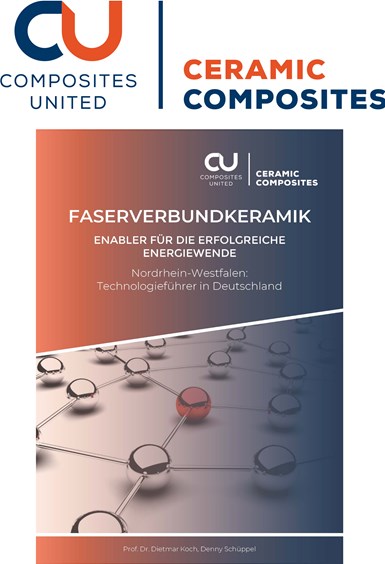RATH prepares for production of advanced oxide ceramic fiber for CMC
New facility in Germany is part of regional supply chain and vision to lead green energy transition using CMC, supported by German government and Composites United’s Ceramic Composites network.
RATH advances as new source for oxide fiber in CMC materials. Michael Roth, German state parliament candidate, can be seen holding a spool of oxide fiber at RATH site in Mönchengladbach, Germany. From left to right: Denny Schüppel (Composites United), Dr. Peter Mechich (DLR), state parliament candidate Michael Roth and from RATH: Christopher Kluthe, Dr. Philipp Franja and Cedric Dreyszas.
For more than 125 years, the RATH Group (Vienna, Austria) has combined materials expertise, application know-how and personal consulting to provide high-temperature materials for unique applications. It is now breaking ground for a new facility in Mönchengladbach, Germany where RATH is developing a high-end oxide ceramic fiber, a key component for the production of fiber-reinforced ceramics known as ceramic matrix composites (CMC).
This market has been dominated by only one American fiber manufacturer. RATH seeks to change that, because broad use of these high-tech materials promises to make the green energy transition more efficient and ecological. “Wherever lightweight design meets high temperatures, we need CMC materials,” Christopher Kluthe says, responsible for ceramic continuous fibers in the Rath Group. “Fiber composite ceramics are based on the broad market availability of oxide ceramic fibers. Only in this way will these technologies be able to make their contribution to the energy transition.”
On May 3, key representatives from industry and research met with German state parliament candidate Michael Roth at RATH GmbH in Mönchengladbach to jointly discuss new technologies for the energy transition. In addition to Kluthe, this meeting was attended by Dr. Philipp Frania, plant manager for RATH; Dr. Peter Mechnich, co-department head at the DLR Institute for Materials Research in Cologne, Germany and Denny Schüppel, managing director of Ceramic Composites, said to be the world’s largest specialist network for ceramic composites, which has been formed within the German composites association, Composites United e. V. (Berlin).
Participants in the May meeting at Mönchengladbach learned about the new material to be produced there and the new possibilities it offers. “Technologically disruptive leap innovations are what the country needs to retain industrial jobs and drive green energy supply,” German parliament candidate Roth said. “It's great that small- and medium-sized businesses in my home country can contribute to this. I am happy to support RATH in this effort.”
With the closely meshed network of research and industry, the North Rhine-Westphalia (NRW) region where RATH Mönchengladbach is located, can become Evoa pioneer in the energy transition. Strong partners from research, such as the German Aerospace Center (DLR) and the Jülich Research Center (Jülich, Germany) — which is a member of the Helmholtz Association of German Research Centers, one of the largest interdisciplinary research centers in Europe — are reported to be just as active as small and large companies. From component manufacturers, such as WPX fiber ceramics (Bonn, Germany), to quality assurance at Diondo (Hattingen), to users such as Ford (Cologne), Linde (Lindlar) and Evonik (Essen), the partners in the NRW region represent the entire value network and are positioning themselves as pioneers of the energy transition.
“Especially the generation of green hydrogen is currently still accompanied by high energy losses. We want to improve that significantly in the future. The green energy transition needs CMC.” — Denny Schüppel, managing director, Ceramic Composites network

“Especially the close cooperation between industry, SMEs and research predestines the region and the network to develop innovative solutions from CMC quickly and in a target-oriented manner,” Mechnich from DLR says. He himself has been conducting research at the DLR Institute for Materials Research in Cologne for more than 20 years. “Reliable, regional supply chains pave the way for innovative technologies and products.” Whether these are technologies for saving energy, or for generating or converting green hydrogen into electricity, “the energy transition needs CMC and we care about helping here,” Schüppel of Composites United notes. “Especially the generation of green hydrogen is currently still accompanied by high energy losses. We want to improve that significantly in the future."
The first components with RATH fibers have already been manufactured. Work is underway in an EU project to compete with the current global players, and soon it will be said: Companies and research institutions in NRW are taking a leading role for technologies of the energy transition.
Related Content
Arceon introduces novel CMC materials for space, defense
Carbeon C/C-SiC ceramic matrix composites are being developed and tested for rocket nozzles, onboard the International Space Station and in electric aviation, metal treatment and reactor applications.
Read MoreCIRA qualifies CMC structures for the reusable Space Rider
Italian team designs, builds and tests multiple large, complex thermal protection system structures made from patented ISiComp C/C-SiC ceramic matrix composites.
Read MoreConverting carbon fiber for UHTCMC to 3500°C
Advanced Ceramic Fibers LLC demonstrates ultra-high temperature ceramic matrix composites using SiC and other metallic carbides for applications in aerospace, defense, energy and more.
Read MoreNew CMC turbine vanes successfully tested in wind tunnel
SiC/SiC ceramic matrix composite (CMC) inlet guide vanes for a high-pressure turbine are aimed for a geared turbofan and show promise for more efficient aeroengines with less weight and need for cooling.
Read MoreRead Next
Cutting 100 pounds, certification time for the X-59 nose cone
Swift Engineering used HyperX software to remove 100 pounds from 38-foot graphite/epoxy cored nose cone for X-59 supersonic aircraft.
Read MoreScaling up, optimizing the flax fiber composite camper
Greenlander’s Sherpa RV cab, which is largely constructed from flax fiber/bio-epoxy sandwich panels, nears commercial production readiness and next-generation scale-up.
Read MoreCeramic matrix composites: Faster, cheaper, higher temperature
New players proliferate, increasing CMC materials and manufacturing capacity, novel processes and automation to meet demand for higher part volumes and performance.
Read More












